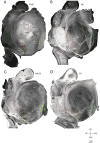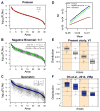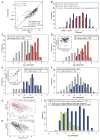The Mouse Cortical Connectome, Characterized by an Ultra-Dense Cortical Graph, Maintains Specificity by Distinct Connectivity Profiles
- PMID: 29420935
- PMCID: PMC5958229
- DOI: 10.1016/j.neuron.2017.12.037
The Mouse Cortical Connectome, Characterized by an Ultra-Dense Cortical Graph, Maintains Specificity by Distinct Connectivity Profiles
Abstract
The inter-areal wiring pattern of the mouse cerebral cortex was analyzed in relation to a refined parcellation of cortical areas. Twenty-seven retrograde tracer injections were made in 19 areas of a 47-area parcellation of the mouse neocortex. Flat mounts of the cortex and multiple histological markers enabled detailed counts of labeled neurons in individual areas. The observed log-normal distribution of connection weights to each cortical area spans 5 orders of magnitude and reveals a distinct connectivity profile for each area, analogous to that observed in macaques. The cortical network has a density of 97%, considerably higher than the 66% density reported in macaques. A weighted graph analysis reveals a similar global efficiency but weaker spatial clustering compared with that reported in macaques. The consistency, precision of the connectivity profile, density, and weighted graph analysis of the present data differ significantly from those obtained in earlier studies in the mouse.
Keywords: anatomy; connectivity; log-normal; neocortex; retrograde; rodent; tract-tracing.
Copyright © 2017 Elsevier Inc. All rights reserved.
Conflict of interest statement
The authors declare no competing interests.
Figures








Similar articles
-
Structural Attributes and Principles of the Neocortical Connectome in the Marmoset Monkey.Cereb Cortex. 2021 Nov 23;32(1):15-28. doi: 10.1093/cercor/bhab191. Cereb Cortex. 2021. PMID: 34274966 Free PMC article.
-
Why data coherence and quality is critical for understanding interareal cortical networks.Neuroimage. 2013 Oct 15;80:37-45. doi: 10.1016/j.neuroimage.2013.04.031. Epub 2013 Apr 18. Neuroimage. 2013. PMID: 23603347 Review.
-
Statistical Analysis of Tract-Tracing Experiments Demonstrates a Dense, Complex Cortical Network in the Mouse.PLoS Comput Biol. 2016 Sep 12;12(9):e1005104. doi: 10.1371/journal.pcbi.1005104. eCollection 2016 Sep. PLoS Comput Biol. 2016. PMID: 27617835 Free PMC article.
-
Spatial Embedding and Wiring Cost Constrain the Functional Layout of the Cortical Network of Rodents and Primates.PLoS Biol. 2016 Jul 21;14(7):e1002512. doi: 10.1371/journal.pbio.1002512. eCollection 2016 Jul. PLoS Biol. 2016. PMID: 27441598 Free PMC article.
-
The meso-connectomes of mouse, marmoset, and macaque: network organization and the emergence of higher cognition.Cereb Cortex. 2024 May 2;34(5):bhae174. doi: 10.1093/cercor/bhae174. Cereb Cortex. 2024. PMID: 38771244 Free PMC article. Review.
Cited by
-
Facilitating the propagation of spiking activity in feedforward networks by including feedback.PLoS Comput Biol. 2020 Aug 10;16(8):e1008033. doi: 10.1371/journal.pcbi.1008033. eCollection 2020 Aug. PLoS Comput Biol. 2020. PMID: 32776924 Free PMC article.
-
Predictive Processing: A Canonical Cortical Computation.Neuron. 2018 Oct 24;100(2):424-435. doi: 10.1016/j.neuron.2018.10.003. Neuron. 2018. PMID: 30359606 Free PMC article. Review.
-
From mouse to man-a bridge too far?Natl Sci Rev. 2020 Jul;7(7):1258-1259. doi: 10.1093/nsr/nwz225. Epub 2020 Jan 6. Natl Sci Rev. 2020. PMID: 34692150 Free PMC article. No abstract available.
-
Multisensory task demands temporally extend the causal requirement for visual cortex in perception.Nat Commun. 2022 May 23;13(1):2864. doi: 10.1038/s41467-022-30600-4. Nat Commun. 2022. PMID: 35606448 Free PMC article.
-
Structural Attributes and Principles of the Neocortical Connectome in the Marmoset Monkey.Cereb Cortex. 2021 Nov 23;32(1):15-28. doi: 10.1093/cercor/bhab191. Cereb Cortex. 2021. PMID: 34274966 Free PMC article.
References
-
- Akaike H. A new look at the statistical model identification. IEEE Transactions on Automatic Control. 1974;19:716–723.
Publication types
MeSH terms
Grants and funding
LinkOut - more resources
Full Text Sources
Other Literature Sources
Molecular Biology Databases

